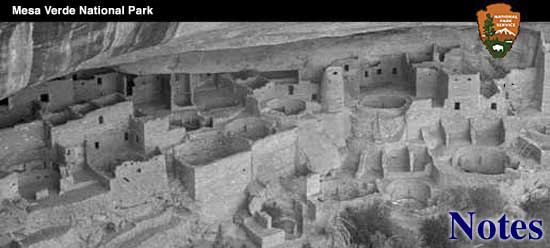

|
Ever since last December there has been considerable interest among the residents of Durango concerning the Moving Mountain and the cause and extent of its movement. The mountain is located three miles south of Durango and consists of that portion of a conspicuous east-west trending ridge that has been cut through by the Las Animas River and is slipping away. Numerous articles appearing in the newspapers about the Moving Mountain have aroused a nation-wide interest in the phenomenon and this summer many visitors to the Mesa Verde who have seen the Moving Mountain or who are going to see it, have inquired concerning the causes of the movement and whether it would be worthwhile to stop off and see it. In order to be able to answer such questions trustworthily I was sent by our Park Naturalist, Mr. Frank, to make an examination of the mountain and to express my views in an article in the Mesa Verde Notes. Carbon Mountain, from which the rock constituting the Moving Mountain has been and is being derived, is the local name of the ridge mentioned above. It is made up of three geologic formations which differ considerably in the resistance offered to erosion: the Lewis shale, the Pictured Cliffs sandstone, and the Fruitland formation. The Lewis shale, constituting the lower portion of the north slope of the mountain, is made up of consolidated muds which are rather easily removed but the complete immediate removal of this shaly material in the Lewis formation is delayed by the capping of Pictured Cliffs sandstone which covers the Lewis shale to the south and forms the main backbone of Carbon Mountain. The Pictured Cliffs sandstone being made up principally of consolidated grains of quartz is not as easily eroded as the Lewis shale and consequently stands up higher than the Lewis shale which it protects where covering it. On top, to the south, of the Pictured Cliffs sandstone is the Fruitland formation consisting of alternating beds of sandstone and shale with seams of coal included. The small dump heaps on the Fruitland formation where it has been exposed along the banks of the Animas River give evidence that at one time the coal in the formation was worked. The fact that the Fruitland formation is made up of rather easily removed shale and coal beds along with more resistant beds of sandstone, combined with the fact that there is no protective cap-rock as in the case of the Pictured Cliffs capping the Lewis shale, makes the entire formation easily influenced by any great agent, be it wind, water, frost action, the pull of gravity, the work of burrowing animals or the roots of plants. Where these three formations, constituting Carbon Mountain, have been cut through by the Animas River, the steepness of the mountain's east slope bordering the river has been so great that the resulting pull of gravity has been too strong for the easily susceptible Fruitland Formation. It has succumbed to the forces of nature, the most important in this case being gravity, to permit the entire top of itself to cave away and move off towards the Animas River to form the Moving Mountain. No other forces are involved. The reports made in newspapers and by individuals that the movement was a reflection of the recent California earthquake, or that burning coal deposits or the ignition of a huge gas pocket in a subterranean coal bed or the caving in of old mine shafts caused the breaking away of the rock above and resulted in it sloughing off are without foundation. The odor of sulphur which is sometimes noticeable is merely due to the disturbance of sulphur deposits in the formation where exposed on the surface and is not due to any internal disturbance as the burning of coal, the ignition of a gas pocket or the general upheavel of the substrata. Let it be stated again that the Moving Mountain is due principally to the pull of gravity along the steep eastern elope of Carbon Mountain where it is cut through by the Animas River. The weakness of the Fruitland formation, which forms the top of the hogback ridge known locally as Carbon Mountain, has resulted in the entire top part, along the west bank of the Animas River, sloughing off and moving down towards the river as a huge landslide fifty-two acres in extent. A landslide of this size is so uncommon it warrants a visit.
| ||||||
| <<< Previous | > Cover < | Next >>> |
vol4-2c.htm
14-Oct-2011